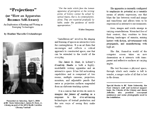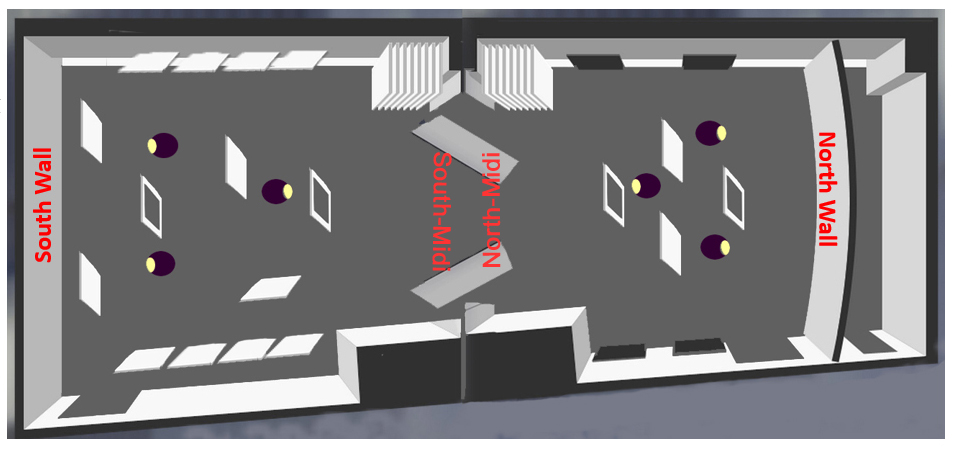The Apparatus: a Description of NCSU's Creativity Studios
"Method of the project: literary montage, I needn’t say anything. Merely show. I shall purloin no valuables, appropriate no ingenious formulations. But the rags, the refuse—these I will not inventory but allow, in the only way possible, to come into their own: by making use of them."
- Walter Benjamin
The James B. Hunt, Jr. Library’s Creativity Studio is both a highly-modifiable writing apparatus and an interactive space. It has full networking capabilities and is comprised of two rooms, multiple cameras, projectors, monitors, and adjustable panels that serve as projection surfaces suspended from an elaborate tracking system.
It is a canvas that invites its users to imagine the future of reading as a response to the ever-advancing technologies of textual production and the new ways of seeing they make visible.
ABOVE: William Blake obsession meets search for Cold War propaganda.
The apparatus was configured to emphasize its potential as a versatile means of artistic expression, one that blurs the line between word and image and transforms and allows texts to be experienced as interactive environments.
ABOVE: A search for advertisements that reached back to the 1700s blended with eye-catching moments of nostalgia for reading.
Images and words emerged in varying constellations. Wrenched free of their context, they combined to form fleeting landscapes of minutia, mixing history with fiction, advertisement with propaganda, and manufacturing with high art.
ABOVE: Klee's 'Angelus Novus' breaks up a close up shot of some flowers I stumbled on many years ago. Benjamin wrote of this painting in his Nineth Thesis on the Philosophy of History: "A Klee drawing named 'Angelus Novus' shows an angel looking as though he is about to move away from something he is fixedly contemplating. His eyes are staring, his mouth is open, his wings are spread. This is how one pictures the angel of history. His face is turned toward the past. Where we perceive a chain of events, he sees one single catastrophe that keeps piling ruin upon ruin and hurls it in front of his feet. The angel would like to stay, awaken the dead, and make whole what has been smashed. But a storm is blowing from Paradise; it has got caught in his wings with such violence that the angel can no longer close them. The storm irresistibly propels him into the future to which his back is turned, while the pile of debris before him grows skyward. This storm is what we call progress."
The flat, framed-in world of the computer screen took on new dimensions as it interacted with transparent and reflective surfaces at varying angles.
ABOVE: Many philosophical and literary themes underlying this story emerged in this image. In the foreground, grocery store orchids wrapped in plastic reflect onto the shiny surfaces of the panels. Henry Miller's Tropic of Cancer was integral to the work of Deleuze who I studied in depth while developing my approach to Benjamin's arcades. The novel itself provides an excellent example of a flâneuristic narrative technique, one that blends the mind of the narrator with his surroundings.
The text became a physical space, through which each reader was left to wander, a unique cache of all that could be remembered of the dream.
Configuration on April 5, 2014
In the final configuration, the panels were arranged so that the four glass panels would align in a staggered fashion, connecting the two rooms in the same way the Parisian passages--arcades--connected otherwise separated parts of the city.
Both doors were left open during the exhibit so as to vary the order in which participants would experience the flow of text.
The swiveling doors adjoining the two rooms were aimed at the Southern corners. If aligned in this manner, both sides of the doors became illuminated, as well as the East and West walls in the South studio. If the swiveling doors were aligned with the Northern corners, the East and West walls in the North studio would be illuminated.
I chose to illuminate the Southwest and Southeast walls because there were already 4 TVs on the Northwest and Northeast walls.
Panels were arranged in front of the South and North walls so as to break up the texts and images, accentuating and modifying their content through the geometry of optics.
Slideshows for North-Midi and South-Midi Walls
Above, the pink arrows indicate the paths of the slideshows projected onto the North-Midi and South-Midi walls which make up the south and north faces of the swiveling doors where the North and South Studios meet.
For the exhibit, these doors were arranged in a V-shape, aligned with the South-West and South-East corners, in order to reflect images onto the East and West walls of the South Studio.
The slideshow is comprised of 62 slides and can be seen HERE. (To access full-screen, simply click on the first image and use your arrow keys to move forward through the slideshow presentation.)
The slideshow was made using Microsoft Powerpoint. Slides faded in and out at intervals of 3-30 seconds. The entire slideshow lasted about 8 minutes but was looped for the duration of the event (approximately 4 hours). The slideshow was started at slide 1 for the North-Midi wall and slide 10 for the South-Midi wall, so the combinations generated were never repeated.
Images were selected based on their aesthetic qualities, the manner in which their content demonstrated or explored key concepts in the study, or as a means of achieving specific effects or highlighting particular trends and differences between the texts.
Slideshows for North Wall and South Wall
Above, the green arrows indicate the paths of the slideshows projected onto the North and South walls which are located at the extreme ends of the studio.
The slideshow is comprised 283 slides formatted at 3620x1080 resolution which were stitched by the two blended pairs of proojectors that faced each of the large walls. The slides can be seen HERE. (To access full-screen, simply click on the first image and use your arrow keys to move forward through the slideshow presentation.)
The slideshow was made using Microsoft Powerpoint. Slides faded in and out at intervals of 3-30 seconds. The entire slideshow lasted about 8 minutes but was looped for the duration of the event (approximately 4 hours). The slideshow was started at slide 1 for the North-Midi wall and slide 10 for the South-Midi wall, so the combinations generated were never repeated.
As with the Midi slideshows, the images for the North and South wall slide shows were chosen for their aesthetic qualities, the manner in which their content demonstrated or explored key concepts in the study, or as a means of achieving specific effects or highlighting particular trends and differences between the texts.
TV Monitor Slideshows
Above, the blue arrows indicate the locations of the four 1920x1080 resolution monitors.
"Artist Statement": Slideshow for the North-East TV Monitor
The slideshow is comprised 8 slides formatted at 1920x1080 resolution which can be seen HERE. (To access full-screen, simply click on the first image and use your arrow keys to move forward through the slideshow presentation.)
The slideshow was made using Microsoft Powerpoint. Slides faded in and out at slow reading speed, looped for the duration of the event (approximately 4 hours).
"Theoretical Background": Slideshow for the South-East TV Monitor
The slideshow is comprised 6 slides formatted at 1920x1080 resolution which can be seen HERE. (To access full-screen, simply click on the first image and use your arrow keys to move forward through the slideshow presentation.)
The slideshow was made using Microsoft Powerpoint. Slides faded in and out at slow reading speed, looped for the duration of the event (approximately 4 hours).
"Process": Slideshow for the South-West TV Monitor
The slideshow is comprised 12 slides formatted at 1920x1080 resolution which can be seen HERE. (To access full-screen, simply click on the first image and use your arrow keys to move forward through the slideshow presentation.)
The slideshow was made using Microsoft Powerpoint. Slides faded in and out at slow reading speed, looped for the duration of the event (approximately 4 hours).
"Inviting Visitor Participation": Slideshow for the North-West TV Monitor
The slideshow is comprised 19 slides formatted at 1920x1080 resolution which can be seen HERE. (To access full-screen, simply click on the first image and use your arrow keys to move forward through the slideshow presentation.)
The slideshow was made using Microsoft Powerpoint. Slides faded in and out at slow reading speed, looped for the duration of the event (approximately 4 hours).
ABOVE: The above images and specifications were taken from NCSU's information website for the Creativity Studio available at https://magnolia.lib.ncsu.edu/tech_specs/?room=crn
ABOVE: NCSU's Standard Configuration is pictured. Panels are typically stored providing the most amount of open space. The studio has various furnishings, among them several chairs and tables.




























